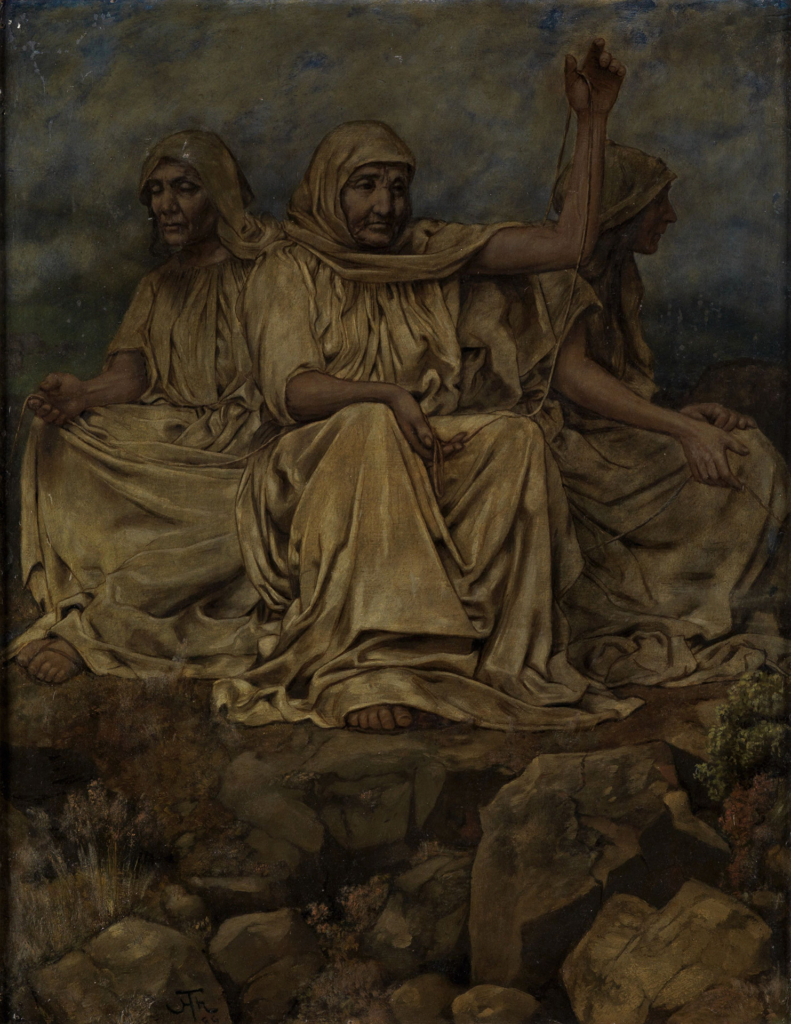
| X (Twitter) | |
|---|---|
URL kopieren
Die URL wurde erfolgreich kopiert und befindet sich in der Zwischenablage |
|
Im Zuge des Website-Relaunchs finden Sie hier vorerst keine hochauflösenden Abbildungen. Im Hintergrund arbeiten wir daran, sie Ihnen an dieser Stelle schnellstmöglich präsentieren zu können. Bis dahin wenden Sie sich gerne per Mail an digital@kunsthalle-karlsruhe.de, wenn Sie Abbildungen in hoher Auflösung benötigen.
The Nordic Fates
Hans Thoma
H 77.5cm W 100cm
1889
KunsthalleKarlsruhe@ZKM
Hans Thoma the artist
Monumental drapery folds
Fold upon fold of a uniformly rough material. At first glance, this may look like a practical exercise in textile painting, but on closer inspection it turns out to be informed by a contemporary ideology.
A museum-in-a-museum for the director
In 1909, Hans Thoma celebrated his 70th birthday. As the director of the Grand Ducal Gallery in Karlsruhe and, above all, a successful German artist, he was honoured with the accolade of a Thoma Museum in one wing of the gallery.
Designed to pay tribute solely to Thoma’s works, his dedicated museum also integrated architecturally and iconographically the so-called Thoma Chapel whose design and decorations had already been commissioned by the Grand Duke years before.
In 1910, the following year, Thoma gifted 89 of his paintings to the Grand Ducal Gallery, creating the basis for the major collection of his works now in the Kunsthalle Karlsruhe. The Norns also entered the collection at that time, though rather than donated by Thoma himself, this was a gift from his friend Countess Luisa Erdödy.
In a Nordic guise
The Norns presents a variation of the three goddesses generally known as the Fates – the Parcae in Roman mythology or the Moirai as the Greek equivalent. From the classical world to Thoma’s own lifetime, the Fates were a recurring motif in European art, but for this work he turned to their corresponding figures in Norse mythology.
The three women, all different ages, depict the Norns of the past, present, and future – Urd, Verdandi, and Skuld. The source of their sacred well springs from the rock they are sitting on as they spin the threads of fate.
The strikingly subdued mood of the painting, rendered in beige and grey, also illustrates one feature of Thoma’s artistic practices. Occasionally, he mixed brown pigment into the varnish, allowing him to create a particular tonal quality in individual areas or, indeed, across the entire surface. He used this technique in other paintings to produce, for instance, the effect of the light in southern Europe.
Evidently in The Norns, he was taken with the idea of an image suspended in time, seen as if through a mist. After all, the subject of these Nordic goddesses offered little in terms of a pictorial tradition.
Instead, “discovered” in literature in the context of Imperial Germany’s burgeoning ethno-nationalist movement, they were given a concrete visual form, in particular, in the circles associated with the composer Richard Wagner.
Clothes maketh the Norns
Wagner’s major work, his cycle of four operas comprising Der Ring des Nibelungen, was not only inspired by Germanic heroic legend, but also pagan Germanic myths. In this work, he gave the Norns a leading role.
At the opening of the Twilight of the Gods, the final part of the Ring cycle, the Norns are weaving the Rope of Destiny. Suddenly, it breaks – ushering in the end of the gods. The stage costumes for the Norns triggered a political debate; should they be based on Greco-Roman culture or some unknown, allegedly Nordic or Germanic tradition?
Carl Emil Doepler, Bayreuth’s costume designer at that time, depicted the Norns with rather straggly hair styles, but dressed in robes inspired by classical ideals. Under the protection of the Yggfrasil, the sacred ash tree, they sit facing one another holding a very solid-looking rope.
Thoma deliberately distanced himself from this image. His rather static yet monumental, brooding Norns, like independent elemental forces, are set in a barren landscape in garments devoid of bows or decorative flourishes.
In place of elegant antique-style robes, they are dressed in reams of rough linen with strong drapery folds creating a unity between the figures. Moreover, by giving them heavy headscarves, Thoma largely avoided the question of hairstyles. Only the Rope of Destiny is delicate and fragile, in keeping with the theme.
A systematic reinterpretation
Thoma thus invented an iconography for the völkisch ethno-nationalist idea of a common primaeval Germanic origin. By interpreting this key motif in Wagner in a way more radical and, from the perspective of the völkisch milieu, more modern, Thoma made a name for himself in those circles in Frankfurt am Main.
Through Wagner’s personal physician Otto Eiser, also consulted by Thoma on medical issues, the composer and artist came to be friends. Hardly surprisingly, then, Cosima Wagner asked Thoma to design new costumes for Bayreuth in the 1890s, a commission he successfully completed.
Hans Thoma’s Norns was acquired by Countess Luisa Erdödy, an important art patron. As yet, no written evidence has been found to indicate the date when it was purchased.
Although the Countess and Thoma conducted a lively correspondence, the date is not mentioned in their letters. Nonetheless, since Erdödy thought very highly of Wagner, the iconographic allusion to his Ring cycle should not be underestimated. The Countess was herself a talented pianist whose previous teachers included Franz Liszt. Under the pseudonym LIOS, she also enjoyed considerable success with her own compositions of romantic songs.
She did not only seek a connection to music in Thoma’s works; she also bought his Im Paradies (In Paradise), similarly donated in 1910 to the Thoma Museum in the Grand Ducal Gallery.
Basic data
| Title | The Nordic Fates |
|---|---|
| Artist | Hans Thoma |
| Date | 1889 |
| Measurements Plastic | H 100cm W 77.5cm |
| Material | Oil on board |